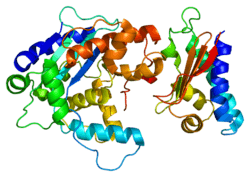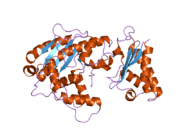CNOT7
CCR4-NOT transcription complex subunit 7 is a protein that in humans is encoded by the CNOT7 gene.[5][6][7][8]
Function
The protein encoded by this gene binds to an anti-proliferative protein, B-cell translocation protein 1, which negatively regulates cell proliferation. Binding of the two proteins, which is driven by phosphorylation of the anti-proliferative protein, causes signaling events in cell division that lead to changes in cell proliferation associated with cell-cell contact. The protein has both mouse and yeast orthologs. Alternate splicing of this gene results in two transcript variants encoding different isoforms.[8]
Interactions
CNOT7 has been shown to interact with:
References
- 1 2 3 GRCh38: Ensembl release 89: ENSG00000198791 - Ensembl, May 2017
- 1 2 3 GRCm38: Ensembl release 89: ENSMUSG00000031601 - Ensembl, May 2017
- ↑ "Human PubMed Reference:".
- ↑ "Mouse PubMed Reference:".
- ↑ Albert TK, Lemaire M, van Berkum NL, Gentz R, Collart MA, Timmers HT (March 2000). "Isolation and characterization of human orthologs of yeast CCR4-NOT complex subunits". Nucleic Acids Res. 28 (3): 809–17. doi:10.1093/nar/28.3.809. PMC 102560. PMID 10637334.
- ↑ Adams MD, Dubnick M, Kerlavage AR, Moreno R, Kelley JM, Utterback TR, Nagle JW, Fields C, Venter JC (March 1992). "Sequence identification of 2,375 human brain genes". Nature. 355 (6361): 632–4. doi:10.1038/355632a0. PMID 1538749.
- ↑ Robin-Lespinasse Y, Sentis S, Kolytcheff C, Rostan MC, Corbo L, Le Romancer M (February 2007). "hCAF1, a new regulator of PRMT1-dependent arginine methylation". J. Cell Sci. 120 (Pt 4): 638–47. doi:10.1242/jcs.03357. PMID 17264152.
- 1 2 "Entrez Gene: CNOT7 CCR4-NOT transcription complex, subunit 7".
- ↑ Bogdan JA, Adams-Burton C, Pedicord DL, Sukovich DA, Benfield PA, Corjay MH, Stoltenborg JK, Dicker IB (December 1998). "Human carbon catabolite repressor protein (CCR4)-associative factor 1: cloning, expression and characterization of its interaction with the B-cell translocation protein BTG1". Biochem. J. 336 ( Pt 2): 471–81. PMC 1219893. PMID 9820826.
- ↑ Prévôt D, Morel AP, Voeltzel T, Rostan MC, Rimokh R, Magaud JP, Corbo L (March 2001). "Relationships of the antiproliferative proteins BTG1 and BTG2 with CAF1, the human homolog of a component of the yeast CCR4 transcriptional complex: involvement in estrogen receptor alpha signaling pathway". J. Biol. Chem. 276 (13): 9640–8. doi:10.1074/jbc.M008201200. PMID 11136725.
- 1 2 Funakoshi Y, Doi Y, Hosoda N, Uchida N, Osawa M, Shimada I, Tsujimoto M, Suzuki T, Katada T, Hoshino S (December 2007). "Mechanism of mRNA deadenylation: evidence for a molecular interplay between translation termination factor eRF3 and mRNA deadenylases". Genes Dev. 21 (23): 3135–48. doi:10.1101/gad.1597707. PMC 2081979. PMID 18056425.
- 1 2 Ikematsu N, Yoshida Y, Kawamura-Tsuzuku J, Ohsugi M, Onda M, Hirai M, Fujimoto J, Yamamoto T (December 1999). "Tob2, a novel anti-proliferative Tob/BTG1 family member, associates with a component of the CCR4 transcriptional regulatory complex capable of binding cyclin-dependent kinases". Oncogene. 18 (52): 7432–41. doi:10.1038/sj.onc.1203193. PMID 10602502.
Further reading
- Draper MP, Salvadore C, Denis CL (1995). "Identification of a mouse protein whose homolog in Saccharomyces cerevisiae is a component of the CCR4 transcriptional regulatory complex". Mol. Cell. Biol. 15 (7): 3487–95. PMC 230585. PMID 7791755.
- Maruyama K, Sugano S (1994). "Oligo-capping: a simple method to replace the cap structure of eukaryotic mRNAs with oligoribonucleotides". Gene. 138 (1–2): 171–4. doi:10.1016/0378-1119(94)90802-8. PMID 8125298.
- Hillier LD, Lennon G, Becker M, Bonaldo MF, Chiapelli B, Chissoe S, Dietrich N, DuBuque T, Favello A, Gish W, Hawkins M, Hultman M, Kucaba T, Lacy M, Le M, Le N, Mardis E, Moore B, Morris M, Parsons J, Prange C, Rifkin L, Rohlfing T, Schellenberg K, Bento Soares M, Tan F, Thierry-Meg J, Trevaskis E, Underwood K, Wohldman P, Waterston R, Wilson R, Marra M (1996). "Generation and analysis of 280,000 human expressed sequence tags". Genome Res. 6 (9): 807–28. doi:10.1101/gr.6.9.807. PMID 8889549.
- Suzuki Y, Yoshitomo-Nakagawa K, Maruyama K, Suyama A, Sugano S (1997). "Construction and characterization of a full length-enriched and a 5'-end-enriched cDNA library". Gene. 200 (1–2): 149–56. doi:10.1016/S0378-1119(97)00411-3. PMID 9373149.
- Rouault JP, Prévôt D, Berthet C, Birot AM, Billaud M, Magaud JP, Corbo L (1998). "Interaction of BTG1 and p53-regulated BTG2 gene products with mCaf1, the murine homolog of a component of the yeast CCR4 transcriptional regulatory complex". J. Biol. Chem. 273 (35): 22563–9. doi:10.1074/jbc.273.35.22563. PMID 9712883.
- Bogdan JA, Adams-Burton C, Pedicord DL, Sukovich DA, Benfield PA, Corjay MH, Stoltenborg JK, Dicker IB (1998). "Human carbon catabolite repressor protein (CCR4)-associative factor 1: cloning, expression and characterization of its interaction with the B-cell translocation protein BTG1". Biochem. J. 336 ( Pt 2) (2): 471–81. PMC 1219893. PMID 9820826.
- Ikematsu N, Yoshida Y, Kawamura-Tsuzuku J, Ohsugi M, Onda M, Hirai M, Fujimoto J, Yamamoto T (1999). "Tob2, a novel anti-proliferative Tob/BTG1 family member, associates with a component of the CCR4 transcriptional regulatory complex capable of binding cyclin-dependent kinases". Oncogene. 18 (52): 7432–41. doi:10.1038/sj.onc.1203193. PMID 10602502.
- Prévôt D, Morel AP, Voeltzel T, Rostan MC, Rimokh R, Magaud JP, Corbo L (2001). "Relationships of the antiproliferative proteins BTG1 and BTG2 with CAF1, the human homolog of a component of the yeast CCR4 transcriptional complex: involvement in estrogen receptor alpha signaling pathway". J. Biol. Chem. 276 (13): 9640–8. doi:10.1074/jbc.M008201200. PMID 11136725.
- Yoshida Y, Hosoda E, Nakamura T, Yamamoto T (2001). "Association of ANA, a member of the antiproliferative Tob family proteins, with a Caf1 component of the CCR4 transcriptional regulatory complex". Jpn. J. Cancer Res. 92 (6): 592–6. doi:10.1111/j.1349-7006.2001.tb01135.x. PMID 11429045.
- Flanagan J, Healey S, Young J, Whitehall V, Chenevix-Trench G (2003). "Analysis of the transcription regulator, CNOT7, as a candidate chromosome 8 tumor suppressor gene in colorectal cancer". Int. J. Cancer. 106 (4): 505–9. doi:10.1002/ijc.11264. PMID 12845644.
- Rual JF, Venkatesan K, Hao T, Hirozane-Kishikawa T, Dricot A, Li N, Berriz GF, Gibbons FD, Dreze M, Ayivi-Guedehoussou N, Klitgord N, Simon C, Boxem M, Milstein S, Rosenberg J, Goldberg DS, Zhang LV, Wong SL, Franklin G, Li S, Albala JS, Lim J, Fraughton C, Llamosas E, Cevik S, Bex C, Lamesch P, Sikorski RS, Vandenhaute J, Zoghbi HY, Smolyar A, Bosak S, Sequerra R, Doucette-Stamm L, Cusick ME, Hill DE, Roth FP, Vidal M (2005). "Towards a proteome-scale map of the human protein-protein interaction network". Nature. 437 (7062): 1173–8. doi:10.1038/nature04209. PMID 16189514.
- Kimura K, Wakamatsu A, Suzuki Y, Ota T, Nishikawa T, Yamashita R, Yamamoto J, Sekine M, Tsuritani K, Wakaguri H, Ishii S, Sugiyama T, Saito K, Isono Y, Irie R, Kushida N, Yoneyama T, Otsuka R, Kanda K, Yokoi T, Kondo H, Wagatsuma M, Murakawa K, Ishida S, Ishibashi T, Takahashi-Fujii A, Tanase T, Nagai K, Kikuchi H, Nakai K, Isogai T, Sugano S (2006). "Diversification of transcriptional modulation: large-scale identification and characterization of putative alternative promoters of human genes". Genome Res. 16 (1): 55–65. doi:10.1101/gr.4039406. PMC 1356129. PMID 16344560.
External links
- Human CNOT7 genome location and CNOT7 gene details page in the UCSC Genome Browser.
This article is issued from
Wikipedia.
The text is licensed under Creative Commons - Attribution - Sharealike.
Additional terms may apply for the media files.






